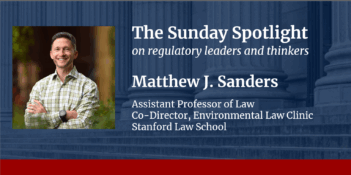
Court disregards the Clean Air Act’s clear language in applying the major questions doctrine to curb EPA’s climate authority.
Law professors dream of the day when the U.S. Supreme Court will rely on one of their publications for a proposition that is crucial to the outcome of an important case. What better validation of all the blood, sweat, and tears that were poured into the publication? What a surge of power to discover that their work has had an impact, if only in the context of a single lawsuit. What an existential high to know that they have finally arrived at the pinnacle.
We experienced none of those emotions when reading Chief Justice John Roberts’ opinion in West Virginia v. EPA. The citations to our work were both minor and innocuous, so that fact helps allay any sense of accomplishment. But equally significant, the Court’s analysis bears little relationship to our own understanding of Section 111(a) of the Clean Air Act.
In West Virginia v. EPA, the Court held that the U.S. Environmental Protection Agency (EPA) was powerless to bring about a reduction in greenhouse gas emissions from coal-fired power plants by inducing them to shift electrical generating capacity from dirty coal-fired plants to cleaner natural gas-fired plants, wind farms, and solar generators.
The Court reached its result by applying the “major questions” doctrine to avoid a deep analysis of the text and legislative history on Section 111(a)’s definition of “standard of performance.” The definition reads as follows:
a standard for emissions of air pollutants which reflects the degree of emission limitations achievable through the application of the best system of emission reduction which (taking into account the cost of achieving such reduction and any nonair quality health and environmental impact and energy requirements) the Administrator determines has been adequately demonstrated.
To address greenhouse gas emissions from existing coal-fired power plants, EPA during the Obama Administration focused on the words “best system of emission reduction” in the definition, rather than on the words “adequately demonstrated,” as it had in issuing many previous standards of performance for new and existing stationary sources. In the past, EPA had usually, but not always, looked for the best adequately demonstrated control technology or process that would reduce emissions when attached to the smokestack, worked into the production processes, or used to increase production efficiency.
In the Obama Administration’s Clean Power Plan, EPA focused on improved heat efficiency, but it also recognized that emissions could be reduced by shifting generating load to sources that yielded fewer emissions per unit of electricity generated—whether owned by the same company or by some other company through a cap-and-trade regime.
In rejecting EPA’s interpretation of the statute, the Court applied a version of the major questions doctrine that prevents agencies from relying on vague statutory language for establishing their authority to decide questions of “vast economic and political significance.”
When such a major question is involved, according to the Court, Chevron deference to agencies goes by the wayside, and a court will presume that Congress did not use vague language to delegate authority to decide the question to the agency. Only when the court is convinced by clear statutory language that Congress has empowered the agency to decide the precise question at issue will the court allow the agency’s action to stand.
The Court found that the generation-shifting issue raised a major question and that the definition of “standard of performance” did not with sufficient clarity empower EPA to rely on generation shifting in providing guidance for states in regulating existing coal-fired plants.
In reaching that conclusion, which we believe to be erroneous, Chief Justice Robert’s majority opinion cited our articles for the proposition that Congress intended for “standards of performance” issued under Section 111(d) of the Clean Air Act to be applied only to individual stationary sources, and it did not intend to allow EPA to require generation shifting among multiple electricity generating sources.
The agency’s shift to focus on the words “best system of emissions reduction” therefore represented an attempt to discover in a long-extant statute an unheralded power that represented a transformative expansion of its regulatory authority. Not only was EPA’s interpretation unprecedented, according to the Court, it also “effected a ‘fundamental revision of the statute, changing it from’” one sort of “‘scheme of… regulation’ into an entirely different kind.” Without ever undertaking an analysis of Congress’s use of the word “system” in the definition of “standard of performance,” the Court simply held that the agency’s focus on that word was misplaced, because anything capable of reducing emissions could qualify as a “system.”
That proposition was a critical point of contention between the majority and the dissenting justices. In her dissenting opinion, Justice Elena Kagan argued that Congress’s use of the word “system” suggested that Congress contemplated approaches such as generation shifting to limit emissions.
Unlike the majority opinion, Justice Kagan’s dissent probed the dictionary definitions of “system” and found them entirely consistent with EPA’s generation-shifting approach.
To the majority’s complaint that “almost anything” capable of reducing emissions could comprise a “system,” Justice Kagan replied: “That is rather the point.” Congress had “used an obviously broad word . . . to give EPA lots of latitude in deciding how to set emissions limits.” When Congress used the word “system,” it was speaking with great clarity because “a broad term is not the same thing as a ‘vague’ one.” EPA was therefore correct in concluding that the plain meaning of “system” referred to “a set of measures that work together to reduce emissions,” and generation shifting fit comfortably within that meaning.
Justice Kagan supported her textual analysis with a convincing analysis of the legislative history of Section 111. Chief Justice Roberts did not have to go to that trouble, because he could rely on the major questions doctrine, which only required the Court to find it “‘highly unlikely that Congress would leave’ to ‘agency discretion’ the decision of how much coal-based generation there should be over the coming decades.”
We believe that EPA’s focus on the “best system of emission reduction” in the Clean Power Plan was a legitimate attempt to use authority that Congress granted to that agency to address problems such as climate disruption that Congress did not envision when it wrote the statute in 1970.
The agency did not “newly discover” that authority. It had been there all along, but the agency rarely had occasion to use it. With the discovery that greenhouse gases were contributing to climate disruption and that there was no available technology to remove them from coal-fired power plant emissions, EPA now needed to focus on systems, rather than on technologies for individual sources.
This approach was especially appropriate in the case of the electric power industry because utility companies were constantly shifting load from plants where the cost of producing a megawatt of power was expensive to available plants where the cost was less expensive. The focus on the “best system of emission reduction,” rather than on “adequately demonstrated” technologies, was hardly transformative. It represented a choice between two tools that Congress had always provided to EPA to use in establishing performance standards for new stationary sources and guidelines for states to use in addressing otherwise unregulated emissions from existing stationary sources.
In West Virginia v. EPA, the Court positioned itself—rather than the political branches—as the final arbiter over whether Congress’s broad delegations allow agencies to address unanticipated problems that are “economically and politically” significant. The ramifications of this shift in the balance of power will be the source of great controversy in the decades to come.
Yet, in our view, if the Court was looking for an opportunity to expand its power, overturning EPA’s interpretation of Section 111 of the Clean Air Act was a poor choice. By favoring some words in the statute over others, sidelining compelling legal arguments about the meaning of Congress’s use of the word “systems,” and ignoring Congress’s clear intent to address air pollution problems with an ambitious and broad mandate, the Court has laid its expansive new major questions doctrine on a very rickety foundation.





